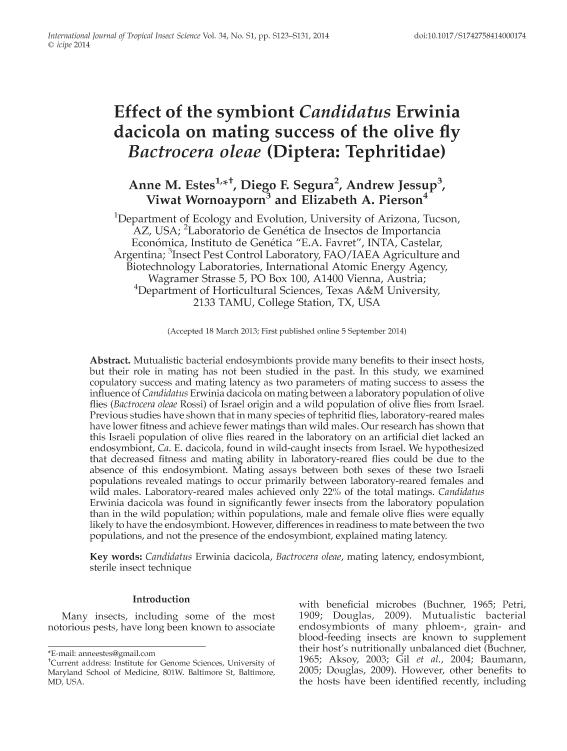Mostrar el registro sencillo del ítem
dc.contributor.author
Estes, Anne M.
dc.contributor.author
Segura, Diego Fernando

dc.contributor.author
Jessup, Andrew
dc.contributor.author
Wornoayporn, Viwat
dc.contributor.author
Pierson, Elizabeth A.
dc.date.available
2018-05-10T17:24:45Z
dc.date.issued
2014-09
dc.identifier.citation
Estes, Anne M.; Segura, Diego Fernando; Jessup, Andrew; Wornoayporn, Viwat; Pierson, Elizabeth A.; Effect of the symbiont Candidatus Erwinia dacicola on mating success of the olive fly Bactrocera oleae (Diptera: Tephritidae); Cambridge University Press; International Journal of Tropical Insect Science; 34; S1; 9-2014; 123-131
dc.identifier.issn
1742-7584
dc.identifier.uri
http://hdl.handle.net/11336/44774
dc.description.abstract
Mutualistic bacterial endosymbionts provide many benefits to their insect hosts, but their role in mating has not been studied in the past. In this study, we examined copulatory success and mating latency as two parameters of mating success to assess the influence of Candidatus Erwinia dacicola on mating between a laboratory population of olive flies (Bactrocera oleae Rossi) of Israel origin and a wild population of olive flies from Israel. Previous studies have shown that in many species of tephritid flies, laboratory-reared males have lower fitness and achieve fewer matings than wild males. Our research has shown that this Israeli population of olive flies reared in the laboratory on an artificial diet lacked an endosymbiont, Ca. E. dacicola, found in wild-caught insects from Israel. We hypothesized that decreased fitness and mating ability in laboratory-reared flies could be due to the absence of this endosymbiont. Mating assays between both sexes of these two Israeli populations revealed matings to occur primarily between laboratory-reared females and wild males. Laboratory-reared males achieved only 22% of the total matings. Candidatus Erwinia dacicola was found in significantly fewer insects from the laboratory population than in the wild population; within populations, male and female olive flies were equally likely to have the endosymbiont. However, differences in readiness to mate between the two populations, and not the presence of the endosymbiont, explained mating latency.
dc.format
application/pdf
dc.language.iso
eng
dc.publisher
Cambridge University Press

dc.rights
info:eu-repo/semantics/openAccess
dc.rights.uri
https://creativecommons.org/licenses/by-nc-sa/2.5/ar/
dc.subject
Candidatus Erwinia Dacicola
dc.subject
Bactrocera Oleae
dc.subject
Mating Latency
dc.subject
Endosymbiont
dc.subject.classification
Otras Ciencias Biológicas

dc.subject.classification
Ciencias Biológicas

dc.subject.classification
CIENCIAS NATURALES Y EXACTAS

dc.title
Effect of the symbiont Candidatus Erwinia dacicola on mating success of the olive fly Bactrocera oleae (Diptera: Tephritidae)
dc.type
info:eu-repo/semantics/article
dc.type
info:ar-repo/semantics/artículo
dc.type
info:eu-repo/semantics/publishedVersion
dc.date.updated
2018-05-10T14:14:55Z
dc.journal.volume
34
dc.journal.number
S1
dc.journal.pagination
123-131
dc.journal.pais
Reino Unido

dc.description.fil
Fil: Estes, Anne M.. University of Arizona; Estados Unidos. Instituto Nacional de Tecnología Agropecuaria. Centro de Investigación en Ciencias Veterinarias y Agronómicas. Instituto de Genética; Argentina
dc.description.fil
Fil: Segura, Diego Fernando. Instituto Nacional de Tecnología Agropecuaria. Centro de Investigación en Ciencias Veterinarias y Agronómicas. Instituto de Genética; Argentina. Consejo Nacional de Investigaciones Científicas y Técnicas; Argentina
dc.description.fil
Fil: Jessup, Andrew. International Atomic Energy Agency; Austria
dc.description.fil
Fil: Wornoayporn, Viwat. International Atomic Energy Agency; Austria
dc.description.fil
Fil: Pierson, Elizabeth A.. Texas A&M University; Estados Unidos
dc.journal.title
International Journal of Tropical Insect Science
dc.relation.alternativeid
info:eu-repo/semantics/altIdentifier/doi/http://dx.doi.org/10.1017/S1742758414000174
dc.relation.alternativeid
info:eu-repo/semantics/altIdentifier/url/https://www.cambridge.org/core/journals/international-journal-of-tropical-insect-science/article/effect-of-the-symbiont-candidatus-erwinia-dacicola-on-mating-success-of-the-olive-fly-bactrocera-oleae-diptera-tephritidae/2BA190262E97A89BFFAABA82F02BD49E
Archivos asociados
